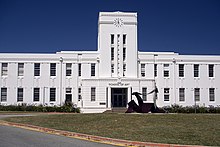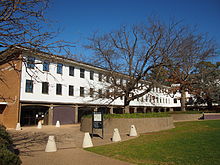The academic structure of the Australian National University is organised as seven academic colleges which contain a network of inter-related faculties, research schools and centres. Each college is responsible for undergraduate and postgraduate education as well as research in its respective field.

ANU College of Arts and Social Sciences
The ANU College of Arts and Social Sciences is divided into the Research School of Social Sciences (RSSS) and Research School of Humanities and the Arts (RSHA).
Within the Research School of Social Sciences there are schools dedicated to history, philosophy, sociology, politics and international relations, Arab and Islamic studies and Latin and American studies.
RSHA contains schools focusing on anthropology, archaeology, classics, art history, English literature, drama, film studies, gender studies, linguistics, European languages as well as an art and music school.
Australian Centre for Indigenous History
The Australian Centre for Indigenous History (ACIH) was established within the ANU School of History, to "raise the profile of the study of Indigenous history through internationally competitive scholarship", among other aims. The centre was officially launched on 28 March 2003, with Senator Aden Ridgeway officiating. Ann McGrath was the founding director, and stayed at the helm until 2019, when Lawrence Bamblett and Maria Nugent were appointed co-directors. Gordon Briscoe was one of two inaugural research fellows at ACIH.
ANU College of Asia and the Pacific
The ANU College of Asia and the Pacific is a specialist centre of Asian and Pacific studies and languages. The College is home to three academic schools: the Crawford School of Public Policy, a research intensive public policy school; the School of Culture History and Language, the nation's centre dedicated to investigating and learning with and about the people, languages, and lands of Asia and the Pacific; and Coral Bell School of Asia Pacific Affairs, Australia's foremost collection of expertise in the politics and international affairs of Asia and the Pacific.
The college also houses the Australian Centre on China in the World (CIW), the Regulatory Institutions Network (RegNet) and the CSCAP Australia.
The College is affiliated with Columbia University's Weatherhead East Asian Institute and Indiana University's Pan Asia Institute.
ANU College of Business and Economics
The ANU College of Business and Economics comprises four Research Schools, of Accounting; Economics; Finance, Actuarial Studies & Statistics; and Management.
ANU College of Engineering, Computing & Cybernetics
The ANU College of Engineering, Computing & Cybernetics is divided into three Schools; School of Engineering, School of Computing and School of Cybernetics. ANU is home to the National Computational Infrastructure National Facility and was a co-founder of NICTA, which was the main information and communications technology research centre in Australia until 2016. At that stage NICTA was merged with CSIRO to form Data 61, a Research Business Unit.
ANU College of Law

The ANU College of Law, established in 1960, conducts legal research and teaching, with centres dedicated to commercial law, international law, public law and environmental law. It is the 7th oldest of Australia's 36 law schools.
ANU College of Health & Medicine

The ANU College of Health & Medicine encompasses the John Curtin School of Medical Research (JCSMR), the ANU Medical School, Research School of Psychology, and National Centre for Epidemiology and Population Health.
ANU College of Science
The ANU College of Physical & Mathematical Sciences comprises the Research Schools of Astronomy & Astrophysics, Biology, Chemistry, Earth Sciences, and Physics; Fenner School of Environment and Society; Mathematical Sciences Institute; and Australian National Centre for the Public Awareness of Science.
Research School of Physics
The ANU Research School of Physics focuses primarily on research into materials science and engineering; lasers, nonlinear optics and photonics; nanotechnology and mesoscopic physics; physics of atoms, molecules and the nucleus; plasma physics and surface science; physics and the environment. Under the direction of Mark Oliphant, nuclear physics was one of the university's most notable early research priorities, leading to the construction of a 500 megajoule homopolar generator and a 7.7 megaelectronvolts cyclotron in the 1950s.

Marie Reay Teaching Centre

The Marie Reay Teaching Centre is located in the Kambri area. It is 6 levels tall and contains classrooms used by a wide variety of subjects, as well as a lecture theatre on the top floor.
University centres
There are individual research centres connected to the University.
- Asia Pacific College of Diplomacy
- Crawford School of Economics and Government
- Australian Primary Health Care Research Institute
- Centre for Aboriginal Economic Policy Research
- Centre for Applied Philosophy and Public Ethics
- Centre for Cross-Cultural Research, 1997–2008?, an ARC Centre of Excellence
- Centre for Mental Health Research
- Centre for the Public Awareness of Science
- Centre for Sustainable Energy Systems
- Eccles Institute of Neuroscience
- Humanities Research Centre
- National Centre for Epidemiology and Population Health
- The National Centre for Information Systems Research
- National Graduate School of Management
- Mathematical Sciences Institute
- The National Europe Centre
Australian National Institute for Public Policy
In May 2010, Prime Minister Kevin Rudd announced a $111.7 million commitment to the development by ANU of a new Australian National Institute for Public Policy. The new National Institute is intended to centralize public policy expertise. A good portion of the funds ($53.1 million) were earmarked for building and developing the previously announced Australian Centre on China in the World, which is one of three specialist centres along with the National Security College and the Australia and New Zealand School of Government to be specifically incorporated under the umbrella of the National Institute. $19.8 million is set aside to create a joint building for the other two centres, with a further $17.3 million expressly dedicated to the National Security College.
References
- "RSSS Schools". Australian National University. Retrieved 6 April 2013.
- "RSHA Schools". Australian National University. Retrieved 6 April 2013.
- "About". School of History. 25 February 2010. Retrieved 24 November 2023.
- "Search titles". ANU Press. Retrieved 24 November 2023.
- "College at a glance - College of Asia and the Pacific". Australian National University. Retrieved 21 January 2016.
- "Australian member committee of the Council for Security Cooperation in the Asia Pacific (Aus-CSCAP)". ANU Strategic & Defence Studies Centre. Retrieved 2 June 2015.
- Pacific, Dean, ANU College of Asia & the. "Our academic units & institutes".
{{cite web}}: CS1 maint: multiple names: authors list (link) - "Welcome from the Inaugural Directors « Pan Asia Institute". Archived from the original on 15 February 2017. Retrieved 5 March 2017.
- "Schools & centres - ANU College of Business and Economics". Australian National University. Archived from the original on 29 March 2013. Retrieved 6 April 2013.
- "ANU College of Law research centres". Australian National University. Archived from the original on 14 May 2013. Retrieved 6 April 2013.
- "ANU Brochure" (PDF). Australian National University. Retrieved 6 April 2013.
- "About us - Science, Medicine & Health". Australian National University. Retrieved 6 April 2013.
- "The Big Machine" (PDF). Australian National University. Archived from the original (PDF) on 17 May 2013. Retrieved 6 April 2013.
- ANU to establish $111.7m public policy precinct
| Australian National University | |
|---|---|
| Canberra | |
| Campuses | |
| Colleges | |
| The Institute of Advanced Studies | |
| University centres | |
| Residence halls and colleges | |
| Student life | |
| People | |
| History |
|
| Related | |